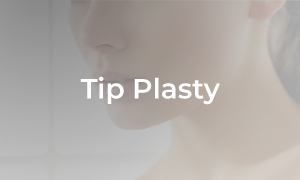Tip Plasty
Tip Plasty
A beautiful nasal tip should be well-defined and well-projected. The nostrils should have ideal size and shape, without an excessive show on the frontal view. A well-defined nasal tip will make the nose looks elegant and enhance the overall beauty of the face. Bulbous nose tip, collapsed nose tip, upturned nose, or overhanging nasal tip are usually undesirable. Various tip-plasty techniques are available to address these unique challenges in nose aesthetics.
The cartilage framework and the overlying skin and soft tissue determine the shape of the nose tip. Asians usually have weak cartilage but thick skin and soft tissue compared to Caucasians. While an L-shaped nasal implant can improve tip projection, the implant can exert excessive pressure on the nasal tip, leading to thinning or even perforation of the skin in the nasal tip. Thus, except for minor to moderate modifications, an implant alone is not an ideal option for a major reshaping of the nasal tip.
Tip-plasty refers to the surgical procedures that reshape the nasal tip using suturing and cartilage graft techniques. Tip-plasty can increase the height and projection of the nose tip, lengthen a short nose, derotate an upturned nose, reduce the bulk of a bulbous nose and correct an overhanging nose tip. Tip-plasty usually is performed via an open rhinoplasty and can be combined with nasal bridge augmentation. The surgeon uses an implant to augment the nose bridge (nose augmentation) and cartilage grafts to reshape the nose tip (tip-plasty). The combination of these techniques enables the creation of an aesthetically balanced nose with minimal risks and complications.
Tip-plasty usually requires the use of autologous cartilage grafts. There are three primary sources of cartilage graft from the patient’s own body:
-
-
-
Ear cartilage is harvested from the external ear through a small opening at the back of the ear. The harvesting will not affect the shape of the ear, and the scar is well hidden behind the ear.
-
Septal cartilage is harvested from the septum inside the nose. The septal cartilage can be harvested during open rhinoplasty. However, the amount of cartilage graft may be insufficient if the nasal septum is small.
-
Rib cartilage is harvested from the lower rib in the chest. Rib cartilage is an option when ear cartilage and septal cartilage are insufficient or if large amount of cartilage graft is required. Rib cartilage can be used for both nose bridge augmentation and tip-plasty.
-
-
Preparation
-
-
-
Inform the doctor of any pre-existing medical conditions and drug allergy. All medical conditions must be treated and stabilized before surgery.
-
Stop smoking at least one week before surgery. Smoking is harmful to wound healing and increases the risks of other post-operation complications.
-
Stop the following medications and supplements from one week before surgery until one week after surgery.
-
All supplements containing vitamin E, ginseng, ginkgo, garlic, fish oil, and other ingredients that increase bleeding during the procedure. Other supplements, traditional medicine, and herbs, in which ingredients are unknown, have to stop as well.
-
Medicine that increases bleeding during the procedure such as aspirin, NSAIDs, and warfarin. However, you may need to consult your physician who prescribed the medication before you stop them.
-
-
On the day of surgery, wear simple and comfortable clothing. Do not wear any makeup. Do not wear any jewelry and metal objects on the face and body.
-
Don’t wear glasses on the day of surgery.
-
-
Surgery
Duration: 1-3 hours
Anaesthesia: Local anaesthesia
Hospitalization: Not required.
Recovery*: Back to work in 3-7 days, light exercise after 2 weeks, heavy exercise after 3-4 weeks. * The actual speed of recovery may vary from person to person.
Surgery Technique*: Tip-plasty usually requires an open rhinoplasty approach (see Introduction to Rhinoplasty). The exact technique may vary, depending on the existing condition of the nose and the desired results. Tip-plasty usually involves reshaping and reinforcement of the cartilage framework with suturing and the use of various cartilage grafts such as septal extension graft, columella strut graft, derotation graft, on-lay graft, shield grafts etc.
Post-operative Care**
-
-
-
What to expect: Swelling usually peaks on the second to third day after surgery and will gradually subside after that. Post-operative pain is usually minimal.
-
General care:
-
Apply the cold pack in the first 3 days. Elevate the head during sleep to reduce swelling.
-
Avoid smoking for at least one month. Smoking increases the risk of wound complications.
-
Good rest and adequate sleep are helpful for a speedy recovery.
-
Avoid applying pressure on the nose. Sleep on the back and do not sleep on one side to avoid pressure on the nose.
-
Do not pick the nostrils with a finger. Instead, use a cotton tip to clean the nose.
-
Be relaxed and calm. Contact the clinic if there are any queries.
-
-
Medicine: Finish the oral antibiotics as prescribed. Take the painkiller as when necessary.
-
Wound care: Clean the wound with a clean cotton tip soaked with sterile water/saline. Apply antibiotic ointment. No wound dressings are required. Remove the adhesive strips applied on the nose after 3 days.
-
Physical activity: Avoid heavy physical activity and exercise for at least one month.
-
Follow-up: Come back one week after surgery for suture removal and review.
-
Emergency: If there is heavy bleeding, a rapid increase in swelling or severe pain, contact the clinic/doctor for advice immediately.
-
-
** The instructions in this list are only for general guidance. If you have any specific queries or concerns during the post-operative recovery, please contact the clinic for further advice.








